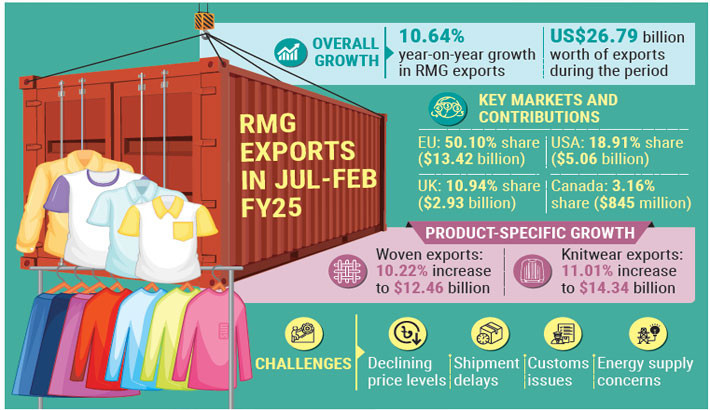
Bangladesh’s ready-made garment (RMG) exports recorded moderate growth of 10.64% in the July–February period of the 2024–25 fiscal year, driven by product quality and price competitiveness in the global market.
Industry insiders anticipate a further 10%–12% increase in RMG exports during the next winter season, provided there is adequate support from banks, customs, and an uninterrupted energy supply to maintain full factory operations.
According to the Export Promotion Bureau (EPB), Bangladesh’s RMG exports reached US$26.79 billion in the first eight months of the current fiscal year.
The European Union (EU) remained the dominant market, accounting for 50.10% of total exports, valued at $13.42 billion.
Exports to the United States amounted to $5.06 billion (18.91% share), while Canada received $845 million (3.16% share).
The United Kingdom was also a key market, with exports worth $2.93 billion, representing 10.94% of Bangladesh’s total RMG exports during this period.
In terms of growth, RMG exports to the EU rose by 11.53% year-on-year, with the US market demonstrating a strong increase of 16.38% and Canada registering 14.12% growth. However, exports to the UK exhibited a more modest rise of 3.74%.
Within the EU, Germany emerged as the most significant market, with exports totalling $3.38 billion, followed by Spain ($2.35 billion), France ($1.43 billion), Italy ($1.05 billion), Poland ($1.13 billion), and the Netherlands ($1.43 billion).
Notable growth was observed in Germany (11.03%), the Netherlands (25.06%), Poland (12.06%), Denmark (14.58%), and Sweden (21.12%).
Industry leaders express optimism
Former President of the Bangladesh Garment Manufacturers and Exporters Association (BGMEA), Faruque Hassan, stated that RMG exports totalled $26.80 billion during this period, marking a substantial increase from $24.22 billion in the previous year.
“This growth reflects the resilience and commitment of our industry towards sustainability and continuous economic progress, despite a 5% global market decline in 2024,” he remarked.
Breaking down the figures further, woven garment exports grew by 10.22%, rising from $11.30 billion in FY24 to $12.46 billion in FY25. The knitwear sector saw even stronger growth of 11.01%, with exports increasing from $12.92 billion to $14.34 billion.
“As we look ahead, we recognise both opportunities and challenges. The government is actively addressing key internal issues, while the industry itself is making strategic adjustments,” said Faruque, who is also the managing director of Giant Group.
He highlighted that declining price levels remain a major concern, requiring strategic business adjustments.
However, the potential for growth in diverse products, fibres, and markets—coupled with trade diversification due to geopolitical tensions and trade wars—presents significant opportunities.
“As we prepare for future milestones, it is essential to carefully strategise our expansion and investment decisions to enhance our capabilities and ensure sustained growth,” he added.
Growth in non-traditional markets
Bangladesh’s RMG sector also showed promise in non-traditional markets, with total exports reaching $4.52 billion, reflecting a 6.23% rise and capturing 16.90% of total exports.
Among these markets, Japan led with imports of $839 million, followed by Australia ($582 million) and India ($478 million).
Exports to Turkey and Mexico also stood out, amounting to $305 million and $229 million, respectively. Growth rates in these markets were particularly strong, with India at 18.58%, Mexico at 25.14%, and Turkey at 32.20%.
Despite positive growth in Japan, Australia, India, Turkey, and Mexico, exports to Russia, South Korea, the UAE, and Malaysia declined during this period.
Focus on competitiveness and future strategies
Former BGMEA Director Mohiuddin Rubel emphasised that the continued growth in exports is heavily reliant on the EU and the United States, which remain Bangladesh’s primary markets.
“The moderate growth in non-traditional markets highlights the need for further research and investment in this segment, as it holds significant potential for expansion.
The ongoing global trade tensions are reshaping market dynamics, creating opportunities that Bangladesh can capitalise on—provided we strengthen our productive capacity,” he noted.
Mohiuddin, who is also the managing director of Bangladesh Apparel Exchange, underscored the importance of investing in backward linkages to enhance the sector’s competitiveness and long-term growth.
Speaking to the Daily Sun, Mohammad Masud Kabir, proprietor of Motex Fashion, acknowledged the challenges faced by the sector but credited Bangladesh’s price competitiveness for sustaining growth.
“During the October–March period, we primarily export summer items such as polo shirts, T-shirts, basic shirts, and trousers. Our prices are relatively lower while maintaining high quality, making them highly attractive to global brands and retailers,” he said.
Looking ahead, he projected a potential 10%–12% growth in RMG exports during the upcoming April–September winter season, contingent on government support.
“To sustain this growth, interest rates must be lowered to a single-digit figure, shipment delays and customs bottlenecks must be addressed, and uninterrupted gas and electricity supply ensured, as we anticipate potential load shedding in the coming months,” he added.


